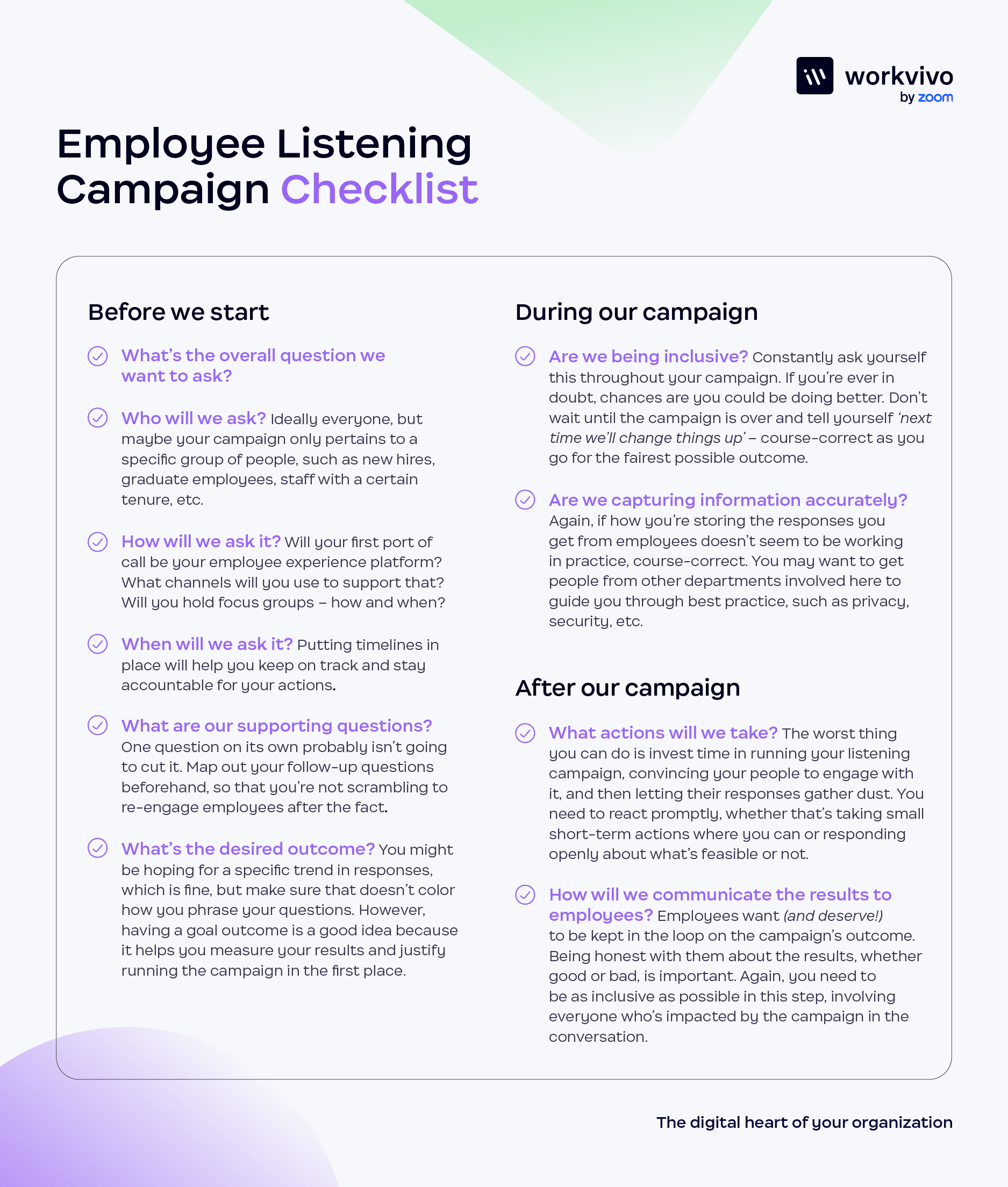How To Plan and Execute a Listening Campaign

Lisa Ardill
Content Editor at Workvivo
30 Apr 2024

Would you consider yourself a good listener?
Let me be more specific.
Do you intentionally take time out of your busy schedule to actively listen to people across your organization?
Whatever your answer, no judgment here – listening is hard! That’s why setting aside time to build a campaign around it can be so helpful: it makes listening an integral part of your company’s strategy rather than just an afterthought, like asking employees to complete a generic feedback survey after an event.
Take Kent as living proof. After acquiring SNC Lavalin’s Oil & Gas business, the integrated energy services provider took the opportunity to map out a new approach to employee experience – and its first step was to find out what its people actually wanted.
The team ran a 12-week listening campaign in which they heard from every single one of their employees, holding workshops, surveys, and more through Workvivo. Mandy McDermott, the company’s Director of Internal Communications, said, “We did it all in a style that’s quite unique to us: complete transparency, complete openness – just building as much trust as we possibly could.”
The result? A culture that was “far more open, less bureaucratic, less hierarchical”, and four core beliefs “that were decided by those 10,000-plus people”.
So there’s our first bit of advice for building a listening campaign: be as open and transparent as possible.
Let’s take a look at some more.
1. Be clear about your goal
Taking steps toward listening more in general is great, but for a successful listening campaign, you need to be more specific. Your campaign should be an aspect of your overall goal to create a culture of active listening.
So, the first thing you need to do is set your objective. What do you want to hear from employees about? Like Kent, it could be getting their inputs into new company values. It can also be feedback on a new policy or initiative, ideas for a new ERG, or an invitation for
2. Take a multi-channel approach
Modern workplaces have a ton of ways to reach their employees, and they should invest just as much in creating channels for two-way conversations and staff feedback.
One of the best ways to host a listening campaign is through an employee experience platform (EXP). With the right technology by your side, you can create dedicated forums and spaces for conversations, publish podcasts explaining your campaign, and build a calendar of events that invite employees to take part.
When you’re ready to start hosting live discussions and focus groups, videoconferencing software is key.
Company leaders can also livestream Q&As through their EXP, answering questions from employees in real time.
3. Invite everyone to the party
Building an open comms workplace is like investing in a flatter hierarchy; every person is empowered to use their voice, whether they’re in the C-suite or a junior member of staff. Hierarchy harms performance and hinders frank conversation, which is a death knell if you’re expecting individuals to come forward with their ideas, feedback, and views.
But a communication model can’t truly be open if you exclude certain employees or groups from it. If you’re holding a listening campaign that impacts something company-wide, then your listening needs to be company-wide too.
4. Consider your tone of voice
Don’t forget that your tone of voice can change a little based on the nature of the conversation too. If you’re running a listening campaign for something like choosing a name for the new boardroom, you can be lighthearted. If you’re seeking insights on why your latest employee satisfaction survey did so poorly, on the other hand, you’ll probably want to keep things pretty formal.
5. Ask the right questions, but leave wiggle room
This one is a bit of a balancing act. You’ll want to ask questions specific enough to get to the root of employees’ thoughts, but you don’t want to be too leading with your wording. Participants should feel able to share as much as they want.
Let’s say your listening campaign is linked to workplace culture.
Try not to ask something like ‘Does leadership actively foster an inclusive work environment?’. In phrasing it like this, you might be encouraging employees to answer with a simple yes or no and not to elaborate.
Instead, ask ‘What steps have you seen leadership take toward a more inclusive work environment?’.
Other examples of culture-related questions include
- When was the last time you felt a sense of belonging at work? What made you feel like that?
- If you could transform elements of the company culture overnight, what would your recommendations be?
- What are some of the behaviors you’d like to see less and more of each day?
6. Take real action
Wherever you can, use employee feedback to implement real change. There’s no point asking for their help if you’re never going to use it, and that will become clear to people pretty quickly.
If you’re hosting a listening campaign around diversity and inclusion, for example, someone might put forward the idea of publishing how much men are paid in your company versus women. Taking this on board and acting on the notion would be a massive show of faith.
And if you simply can’t do what employees want, be honest. Report back on what can’t be achieved and why. Being transparent about what you can and can’t do will go much further than pretending everything is fine and brushing off questions.
7. Rinse and repeat
A listening campaign is an invaluable tool in your internal comms kit, and should never be a once-off. Work listening campaigns into various workplace initiatives and projects throughout the year, particularly around times of upheaval and stress. (It’d be great to set yourself up to only ever hear good things from your staff, but that’s probably not ethical. Or conducive to progress.)
How you go about it doesn’t have to be the same – in fact, you’ll need to evolve your methods as you see what works and what doesn’t anyway. But doing it is key.
Here's your template!
Ready to be a better listener? Our free Listening Campaign Checklist will help get you started.



